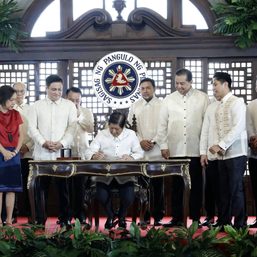SUMMARY
This is AI generated summarization, which may have errors. For context, always refer to the full article.

MANILA, Philippines – The country’s two major state banks – Landbank of the Philippines (Landbank) and the Development Bank of the Philippines (DBP) – are left weakened after the Maharlika Investment Corporation took P75 billion of their capital to set up the controversial sovereign fund.
Now, it seems the state banks are starting to feel the strain of that lost capital, as both Landbank and DBP have requested for “regulatory relief” from the Bangko Sentral ng Pilipinas’ (BSP) capital requirements.
Here’s what it means and why it matters.
What is regulatory relief?
Landbank and DBP are requesting for flexibility from the BSP’s capital adequacy ratio. This refers to the level of capital that banks normally keep on hand to meet the obligations and debts that they have. It also serves as protection from bank runs, or instances where depositors withdraw too much money at once.
For big banks like Landbank and DBP, the central bank requires them to have a capital adequacy ratio of 10%. Think of it as a careful balancing act between keeping enough money in the bank’s vault and giving it out to the bank’s clients through loans.
The challenge comes after Landbank and DBP had P50 billion and P25 billion respectively of their capital taken away from them to fund the Maharlika Investment Corporation. With billions in capital suddenly gone, that balance has now radically tilted. The state banks have to quickly start building up their own capital again to regain balance – or else they’ll violate the BSP’s requirement.
In fact, in DBP’s case, they’re already in danger of violating that 10% capital adequacy ratio.
DBP President Michael de Jesus admitted to Rappler that they “would breach” the capital requirements after remitting their contribution to the Maharlika Investment Corporation.
“Relief is related to the fact that under BSP regulations, our contribution to Maharlika must be deducted from the computation of capital. We seek relief that our contribution not be deducted from capital,” De Jesus told Rappler on Friday, October 13.
Although the regulatory relief wouldn’t eliminate the dangers of a weakened bank, De Jesus said that they’re nevertheless seeking for an exemption because otherwise, they would “be facing sanctions and penalties for any breach.”
The BSP said it is already discussing with these state banks about possibly granting them relief from the capital requirements. (READ: Bangko Sentral may ease requirements for Landbank, DBP after funding Maharlika)
“In principle, we can provide forbearance, which means we can allow them not to comply for a period of time. This is in principle. This is what’s done elsewhere. But they will be expected to comply at some point. Forbearance is always temporary,” BSP Governor Eli Remolona Jr. said on Wednesday, October 11.
How does this affect bank clients?
Giving away so much money has raised concerns that the banks may not be strong enough to continue providing loans to farmers and small businesses the way they used to.
Former BSP Deputy Governor Diwa Guinigundo warned of possible “grave consequences” as the state banks start to tighten their purse.
“Kung hindi nila gusto na bumaba ang kanilang capital adequacy ratio sa level na requirement ng Bangko Sentral, kinakailangan huwag na silang magpautang,” Guinigundo said in a Radyo5 interview on Friday.
(If they don’t want their capital adequacy ratio to go below the required level of the Bangko Sentral, they will need to stop giving loans.)
This could hurt the farmers, small businesses, and households that rely on the loans and programs of Landbank and DBP. In that sense, the lack of capital could get in the way of countryside development.
In the meantime, economists expect the state banks to use the period during regulatory relief to build up their capital again.
”As with any financial institution, if regulatory relief is granted, these risks don’t disappear; they may simply be deferred or mitigated to some extent, thus the need to take proactive steps to rebuild its capital base and ensure long-term stability,” Security Bank chief economist Dan Roces told Rappler on Friday.
In rebuilding their capital, banks may choose to keep their earnings rather than declare dividends and give out less risky loans. They could also seek more investment from shareholders, sell some of their assets, or ask for government support.
What about a worst-case scenario of an impending financial crash?
The state banks may need help from the central bank to prevent their collapse, but then the BSP might find itself having difficulty infusing capital. The central bank’s own dividends were, after all, diverted to the Maharlika Investment Corporation too.
“The paradox of it is while you are getting funds from the BSP that should have been used for capitalizing itself, ito ngayon ay ibibigay mo sa Maharlika Investment Fund. Mas kokonti ‘yung capital na maaring ipangtulong ng Bangko Sentral sa mga financial institutions na nagkakaproblema (you are now giving this to the Maharlika Investment Fund. There will be less capital for the Bangko Sentral to use in helping financial institutions that have problems),” Guinigundo added. – Rappler.com
Add a comment
How does this make you feel?







![[Finterest] Private banking: How the wealthy keep the money within the family](https://www.rappler.com/tachyon/2024/07/Finterest-wealth-between-the-family.jpg?resize=257%2C257&crop=425px%2C0px%2C1080px%2C1080px)

![[In This Economy] What foreigners are saying about the Maharlika fund](https://www.rappler.com/tachyon/2023/12/TL-foreigners-maharlika-fund-dec-1-2023.jpg?resize=257%2C257&crop_strategy=attention)

![[ANALYSIS] Economists vs Maharlika: Some key points](https://www.rappler.com/tachyon/2023/06/maharlika-fund-TL-june-9-2023.jpg?resize=257%2C257&crop=436px%2C0px%2C1080px%2C1080px)

There are no comments yet. Add your comment to start the conversation.